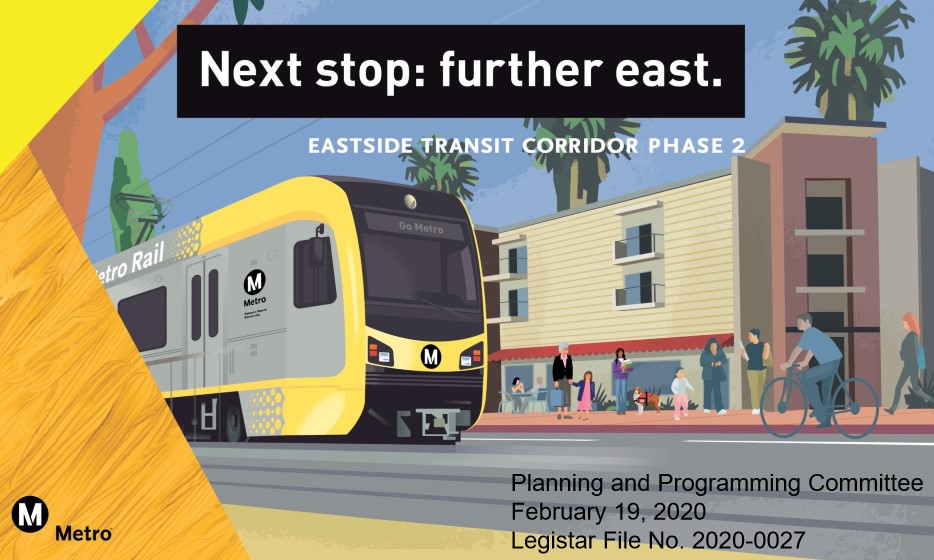Ding-dong, rail along the 60 Freeway is dead!
Well, actually just delayed until around 2053.
Officially called the Eastside Transit Corridor Phase 2, Metro is working on extending the Eastside Gold Line (recently re-named the L Line) eastward. The light rail line currently ends at Atlantic Boulevard, just east of the East L.A. Civic Center.
Metro's Measure M expenditure plan designates two chunks of funding for the project:
- An initial $3 billion alignment will be funded with $1.086 billion from Measure M, plus additional monies from other federal/state/local sources. That initial alignment is scheduled for a 2029 groundbreaking and 2035 operations.
- A second alignment scheduled for 2053/2057 is allocated $2.89 billion.
The Eastside extension project is among several of those identified to be accelerated for completion by the 2028 Olympics. That acceleration is problematic and is more aspirational than actual.

Recent discussions for the next eastside extension included three alternatives. As of 2018, Streetsblog L.A. described them as follows:
- The SR-60 alternative parallels the 60 Freeway through the cities of Montebello and Monterey Park to a terminus in South El Monte. For the most part, the train would run on an aerial structure immediately south of the freeway. Rail stations along freeways tend to be problematic due to car noise and pollution; these sorts of alignments also tend to favor park-and-ride over more desirable transit-oriented development. This alignment is complicated by having to avoid the toxic Operating Industries Inc., Landfill site, immediately south of the freeway in Monterey Park. To avoid the landfill, Metro’s aerial train structures would cross over the freeway, then back again.
- The Washington Boulevard alternative goes through unincorporated East L.A., the cities of Montebello, Commerce, Pico Rivera, and Santa Fe Springs to a terminus in Whittier. This alignment includes a nearly 3-mile subway tunnel below Atlantic Boulevard from 3rd Street to Washington, then rail along Washington mostly at-grade, though with some aerial portions. This alignment serves relatively population-dense, low-income, predominantly Latinx communities.
- The Combined alternative includes both of the above alignments.
Last week, the Metro board Planning and Programming Committee approved moving forward with essentially just the Washington Boulevard alternative.
If a loud polluted freeway and a toxic landfill were not enough to disqualify it, Metro staff (staff report) cited additional "significant environmental and engineering challenges" for the 60 Freeway alignment:
- Caltrans has plans to widen the 60 Freeway, so they are insisting on a 93-foot buffer between the exisiting freeway and any transit infrastructure. The aerial line would extend across the freeway in two places and Caltrans is insisting that no bridge support columns be placed in the freeway median. Metro found that clear-span bridges are feasible, but would necessitate a worsened curve radius, slowing train speeds from 55 mph to 25-30 mph.
- Siting a maintenance yard for the 60 Freeway has been difficult, with only one "constrained" yard site a half-mile east of the eastern terminus.
- Staff was reluctant to share ridership analysis, as current estimates are rough preliminaries. When pressed, they cited projections as follows: SR-60 ~15,000 daily boardings, Washington ~19,000, and Combined ~25,000.
Boardmember and County Supervisor Hilda Solis represents both the eastside alignment areas. She stated that despite being "somewhat torn on both of these, because it's hard to split the baby in half, so to speak," she concurs with staff recommendations for the Washington alignment. Solis suggested that some transit improvements, such as BRT (Bus Rapid Transit), might go to the northern alignment area that would need to wait until the 2050s for its rail extension.
Boardmembers Janice Hahn and Ara Najarian also expressed support for the Washington alignment - as did public comment from representatives from the cities of Commerce, Montebello, Pico Rivera, Santa Fe Springs, and Whittier.
Boardmember and Duarte City Councilmember John Fasana stated that he "accepted" the staff recommendation, but expressed that the San Gabriel Valley region (communities he represents - along the 60 Freeway) is unfairly losing out to the Gateway Cities region (served by the Washington alignment).
The committee approved proceeding with project environmental studies focused on the Washington alignment - under the California Environmental Quality Act (CEQA) only as Metro does not expect to use federal funding for the project. The item is expected to be approved by the full Metro board this Thursday.







